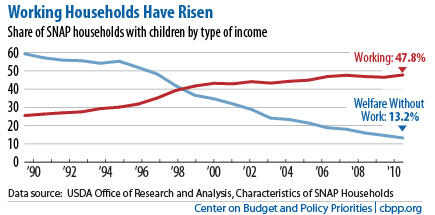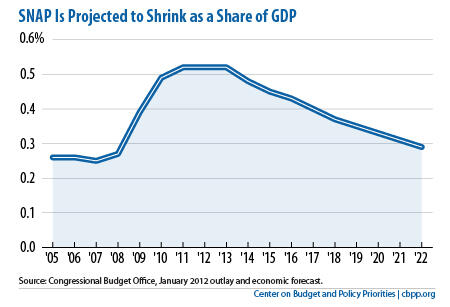BEYOND THE NUMBERS
The Supplemental Nutrition Assistance Program (SNAP), formerly known as the Food Stamp Program, is in the news these days because of comments made by some Republican presidential candidates. Below are five things you probably don’t know about the program.
- A large and growing share of SNAP households are working households (see chart). In 2010, more than three times as many SNAP households worked as relied solely on welfare benefits for their income.
The share of SNAP households with earnings has continued growing in the past few years — albeit at a slower pace — despite the large increase in unemployment.
One reason why SNAP is serving more working families is that, for a growing share of the nation’s workers, having a job has not been enough to keep them out of poverty.
- SNAP responded quickly and effectively to the recession. SNAP spending rose considerably when the recession hit. That’s precisely what SNAP was designed to do: respond quickly to help more low-income families during economic downturns as poverty rises, unemployment mounts, and more people need assistance. In 2010, for example, SNAP kept more than 5 million people out of poverty and lessened the severity of poverty for millions of others, under a poverty measure that counts SNAP benefits as income.
Economists consider SNAP one of the most effective forms of economic stimulus, so SNAP’s quick response to the recession — as well as a temporary benefit increase enacted in the 2009 Recovery Act — helped the broader economy. The Congressional Budget Office (CBO) rated an increase in SNAP benefits as one of the two most cost-effective of all spending and tax options it examined for boosting growth and jobs in a weak economy.
Converting SNAP to a block grant, as some have proposed, would largely destroy its ability to respond to rising need during future recessions, forcing states to cut benefits or create waiting lists for needy families.
- Today’s large SNAP caseloads mostly reflect the extraordinarily deep and prolonged recession and the weak recovery. Long-term unemployment hit record levels in 2010 and has remained extremely high. Today, 43 percent of all unemployed workers have been out of work for more than half a year; the previous post-World War II high was 26 percent in 1983.
Workers who are unemployed for a long time are more likely to deplete their assets, exhaust unemployment insurance, and turn to SNAP for help, since it is one of the few safety net programs available for many long-term unemployed workers. In most states, other programs — such as cash assistance under the Temporary Assistance for Needy Families (TANF) and state General Assistance programs — haven’t responded effectively to rising need during the recession.
More than one in five workers who had been unemployed for over six months received SNAP in 2010, according to Congress’s Joint Economic Committee.
- SNAP has one of the most rigorous quality control systems of any public benefit program. Each year states pull a representative sample (totaling about 50,000 cases nationally) and thoroughly review the accuracy of their eligibility and benefit decisions. Federal officials re-review a subsample of the cases to ensure accuracy in the error rates. States are subject to fiscal penalties if their error rates are persistently higher than the national average.
In 2010, only 3 percent of payments went to ineligible households or to eligible households but in excessive amounts. Payment accuracy has continued to improve in the past few years, despite the large increase in SNAP enrollment. - SNAP’s recent growth is temporary. CBO predicts that SNAP spending will fall as a share of the economy as the economy recovers and the Recovery Act benefit increases expire (see chart). By 2021, SNAP is expected to return nearly to pre-recession levels as a share of the economy.
Over the long term, SNAP is not growing faster than the economy. So, it is not contributing to the nation’s long-term fiscal problems.


